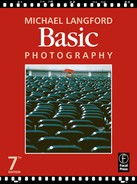‘…Technique is basic to the art of photography’
Beaumont Newhall, Museum of Modern Art (Essays, 1980)
Basic Photography is an introductory textbook, covering the varied skills which lie behind photographic practice. It is intended for students of all ages and, beginning at square one, assumes that you have no theoretical knowledge of photography, nor any scientific background. The book explains equipment and techniques, provides information on how today’s ‘silver halide’ materials and processes work, together with new digital methods of shooting and manipulating pictures. At the same time, since technical know-how and craft skills mean little on their own, the importance of visual content and meaning in photographs is stressed throughout. In short, Basic Photography is planned as a primer for professionals which will interest and inform amateur photographers too.
‘Photography’, or ‘light drawing’, is essentially a combination of technique and visual observation. Developing your ability to make successful photographs must include some basic technical theory, otherwise you will not get the most out of your tools, fully explore materials, or turn out reliable results. This aspect of learning photography is like learning to write: first you have to shape the letters forming words, then spell, then string together sentences and paragraphs. But the individual who can do all this is no writer until he or she has ideas to express through words. In the same way technical theory to the photographer is a means to a visual end, something which allows better control and self-confidence in achieving what you want to say.
Basic Photography opens with a broad look at photography – putting it in context as a versatile and important contemporary medium. Then it goes on to show how photography’s components, procedures and chemical processes fit together. The chapters are laid out in the same order as image production, starting with chapters on light and lenses, and proceeding through cameras, subject lighting, and composition. (These ‘front end’ aspects remain valid whether you use traditional photographic materials, or newer electronic methods of image capture.) The book continues with films, exposure, processing, printing, and finishing.
Many photography courses start off with students using colour (slide) film, to build up confidence in camera handling and picture composition before progressing to more technical aspects of darkroom work. Others begin with black and white photography, which, far from being eclipsed by colour, remains an important creative medium. Reflecting both approaches, Basic Photography covers camera aspects of colour and black and white photography, colour film processing, and black and white processing and printing. This is also logical from the point of view of the vast majority of photographers who begin by shooting colour film and using commercial colour printing services. (Colour printing will be found in the companion volume, Advanced Photography; the history of technical and stylistic movements in photography is described in Story of Photography, also published by Focal Press.)
This seventh edition of Basic Photography is expanded to include new, digital forms of photography. In due course digital imagery will largely take over from traditional chemical-based procedures, especially in amateur photography. But the older processes will still be practised for their own particular qualities, just as black and white continues to be used alongside colour. Chapter 6 explains how digital cameras work, their advantages and limitations. Research and development are proceeding apace here, with industry standards still to be fully agreed. The use of computers to digitally manipulate pictures (particularly those shot on film) is however more established. It is already accepted as an important tool – a rival to the darkroom which every photographer should be able to use. This is covered in Chapter 14.
The text remains in a form that I hope is the most useful for students – either for ‘dip-in’ study, or sequential reading. You will find the summaries at the end of each chapter a good way of checking contents, and revising. Make use too of the Glossary and Appendices at the back of the book.
M.L.
Special thanks from Focal Press go to Sidney Ray who technically checked the page proofs of this edition.
